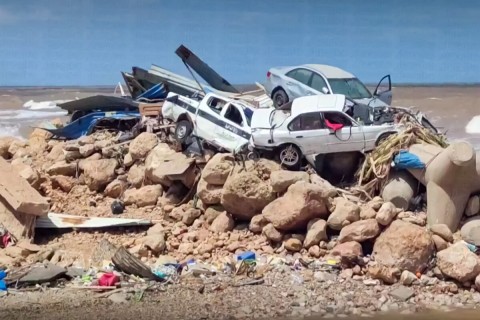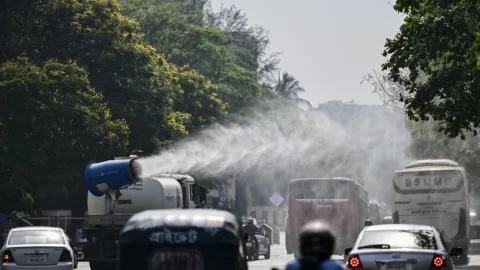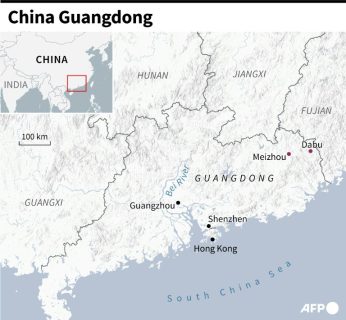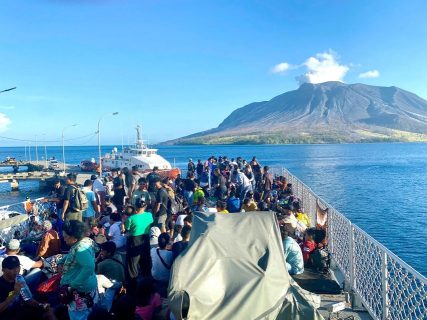Matinding baha na tumama sa Libya na ikinasawi ng libu-libo, dulot ng isang “medicane”

This image grab from footage published on social networks by Libyan al-Masar television channel on September 13 shows a view of piled-up destroyed vehicles in the wake of floods after the Mediterranean storm “Daniel” hit Libya’s eastern city of Derna. – A global effort to assist stricken Libya gathered pace on September 14 after a tsunami-like flood killed nearly 4,000 people and left thousands missing. Military transport aircraft from Middle Eastern and European nations, along with ships, have been ferrying emergency aid to the North African country already scarred by war. (Photo by Al-Masar TV / AFP)
Ang flash flood na pumatay ng libu-libong katao sa Libya ngayong linggo ay kasunod ng isang “medicane,” isang hindi karaniwan ngunit mapangwasak na weather phenomenon na pinaniniwalaan ng mga siyentipiko na tumitindi dahil sa umiinit na mundo.
Ang termino ay pinagsamang salita na Mediterranean at hurricane. Ginagamit ito ng mga siyentipiko at weather forecaster, at hindi gaanong kilala ng mas nakararaming tao.
Ang medicanes, na maaaring mabuo sa mga bahagi ng Mediterranean Sea malapit sa baybayin ng Hilagang Aprika, ay katulad ng hurricanes at typhoons bagama’t maaari itong mabuo sa mas malamig na tubig.
Maaari ring magkaroon ang mga ito ng pisikal na pagkakahawig sa satellite imagery bilang isang umiikot na masa ng mga ulap ng bagyo na nakapalibot sa isang mata sa gitna na nagpapakawala ng napakalakas na hangin at ulan.
Ang bagyong Daniel ay nagbagsak ng tinatayang 170 millimetres ng ulan sa Libya.
Ayon sa mga siyentipiko, pinalalakas pa ito ng global warming.
Sinabi ni University of Reading professor Liz Stephens, “We are confident that climate change is supercharging the rainfall associated with such storms.”
Ang Mediterranean cyclones ay kalimitang mas maliit at mahina kaysa tropical equivalents nito, at may mas maliit na espasyo upang ma-develop.
Ang peak strength nito ay kadalasang katumbas ng isang Category 1 hurricane sa Saffir-Simpson scale, na may bilis ng hanging 119-153 kilometres (74-95 miles) bawat oras.
Paliwanag ni Suzanne Gray, isang propesor sa University of Reading meteorology department, “Medicanes tend to form in the autumn when the sea is warm, usually in the western Mediterranean and the region between the Ionian Sea and the North African coast.”
Aniya, “A layer of colder air from higher altitudes forms convections with warmer air rising from the sea that converge around a centre of low pressure.”
Ayon naman sa US National Oceanic and Atmospheric Administration, “Medicanes form once or twice per year on average. While hurricanes move from east to west, medicanes tend to go from west to east.”
Bago tumama sa Libya, ang bagyong Daniel ay nanalasa muna sa Bulgaria, Greece at Turkey noong isang linggo.
Tatlong medicanes ang tumama sa Greece sa pagitan ng 2016 at 2018, habang noong 2019, natukoy ng Spanish weather services ang isa sa pagitan ng Balearic Islands at ng baybayin ng Algeria.
Ang medicane na may lakas ng hangin na hanggang 120 kilometres per hour, na tinawag na Ianos, ay nanalasa sa Greece noong September 2020, na ikinasawi ng tatlo katao sa siyudad ng Karditsa at nagbunsod ng mga pagbaha, landslides at pagkaputol ng suplay ng kuryente.
Ang Italian island naman ng Sicily ay tinamaan din noong 2021.
Noong 2020, sinabi ng French weather monitor na Meteo-France, na mahirap basahin ang climate signals mula sa medicanes dahil sa pagiging “bihira” nito.
Sa pangkalahatan, sinabi ng mga eksperto na ang pag-init ng temperatura sa ibabaw ng tubig, na dulot ng pagbabago ng klima na gawa ng tao, ay lalo pang magpapatindi sa malakas nang mga bagyo.
Ayon sa mga siyentipiko, “Oceans have absorbed 90 percent of the excess heat produced by human activity since the dawn of the industrial age.”
Sinabi naman ng Spanish researchers, “Mediterranean reached its highest temperature on record in July as Europe baked under a series of heatwaves. The surface waters of the eastern Mediterranean and Atlantic are two to three degrees Celsius warmer than usual, which would have turbocharged Daniel.”
Dagdag pa ng scientist na si Karsten Haustein ng Leipzig University sa Germany, “The fact that Daniel could form into a medicane… is likely a result of warmer sea surface temperatures and hence man-made climate change.”




